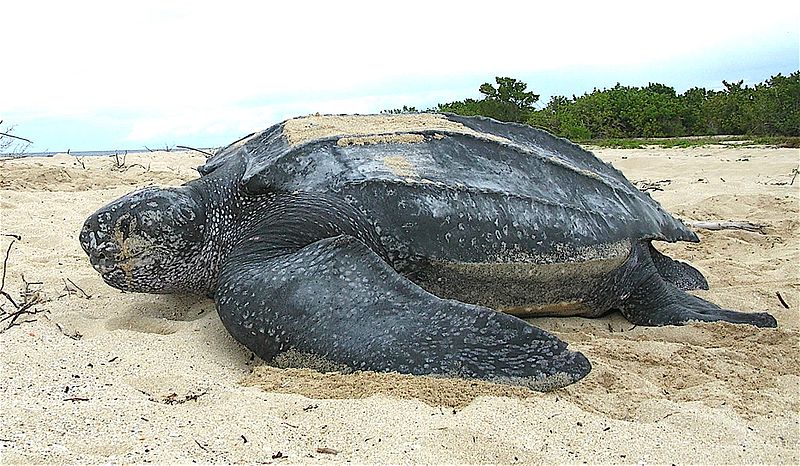
Leatherback Sea Turtle Facts
- The most notable statistic about the truly magnificent Leatherback Sea Turtle remains the fact that it ranks as a legitimate giant of its kind. In point of fact, this truly fabulous animal presently lists as the largest of all known living turtles.
- This remarkable and quite impressive creature also constitutes the fourth heaviest of all living reptiles. Only three of the modern crocodilians surpass it in terms of sheer weight, which remains quite an accomplishment for it.
- The fascinating animal further distinguishes itself from all other sea turtles in another manner, as well. This holds true since the amazing sea reptile represents the only known species of its kind that does not possess a bony shell.
- Sadly, however, the Leatherback Sea Turtle now finds itself facing threats to its existence. As a result, the IUCN now lists it as Vulnerable, on its Red List of Threatened Species. The main threats include chemical and plastic pollution, and boat strikes.
- Most regrettably, the estimated number of nesting females among this reptile has plunged dramatically since 1980. At that time, these numbered about 115,000. Currently, however, that number has dropped to fewer than 43,000.
Related Articles
Leatherback Sea Turtle Physical Description
Without question, in the minds of many, the mature Leatherback Sea Turtle represents a truly impressive sight to see. Some impressive individuals reach a total length of as much as 7.2 ft (2.2 m), and achieve a weight often reaching as much as 1,540 lb (700 kg).
Coincidentally, this breathtaking animal also has the longest front flippers of any turtle. These out-sized appendages average an astonishing length of 8.9 ft (2.7 m). That measurement makes them the longest both in sheer length and relative to body size.
In coloring, the fabulous reptile also displays a dual pattern to its appearance. Its upper carapace typically shows a combination of black and dark gray, while the underside of the body generally presents a significantly lighter color scheme.
It is the outer covering of the Leatherback Sea Turtle, however, that separates it from all others. That’s due to an amazing divergence of evolution. Instead of a bony shell, this creature has a covering of extremely thick, tough leathery skin to protect it.
- Kingdom: Animalia
- Phylum: Chordata
- Class: Reptilia
- Order: Testudines
- Family: Dermochelyidae
- Genus: Dermochelys
- Species: D. coriacea
Leatherback Sea Turtle Distribution, Habitat, and Ecology
It must be pointed out that, thankfully, the marvelous Leatherback Sea Turtle has an almost global range. The majority of its population occurs in the tropical and subtropical oceans. Its range, however, extends from the Arctic Circle to Cape Agulhas, in Africa.
Its population numbers, though, appear to be mainly concentrated in three primary populations. Not only that, but each of these remains slightly genetically distinct from the others. These occurs in the Atlantic, western Pacific, and eastern Pacific oceans.
Each of these do share many of the same traits, however. Firstly, all prefer to inhabit the open ocean. Secondly, all tend to follow their prey as it moves during the day. This often results in it moving from deep water during the day to shallower regions at night.
In an interesting twist, juveniles typically prey on various small species for their food, while the adults feed almost exclusively on various types of jellyfish. In contrast, mature adults has few natural predators. The few include orcas and large sharks.
Despite all these facts, the Leatherback Sea Turtle is perhaps best known for its nesting practices. Although most of its kind return to the exact beach of their birth, it remains less selective. For it, any beach in the same region seems to serve perfectly well.
Species Sharing Its Range
Check out our other articles on 4 Fantastically Fascinating Fungi, Giant Leopard Moth, Milford Sound, Chinese Lantern, Galapagos Penguin, Maned Wolf, California red-sided garter snake
